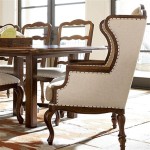How Much Does It Cost To Reupholster Dining Room Chairs?
Reupholstering dining room chairs is a practical alternative to purchasing new furniture. It allows individuals to retain the design and sentimental value of existing pieces while updating their aesthetic appeal and extending their lifespan. Determining the cost of this process involves considering various factors, and this article will delve into the intricacies of pricing, materials, and labor involved in reupholstering dining room chairs.
The cost to reupholster dining room chairs is not a fixed figure. It's subject to fluctuations based on the complexity of the chair design, the type and quantity of fabric selected, the condition of the chair's frame and padding, and the local labor rates. A simple, armless dining chair without intricate details will generally cost less to reupholster than a chair with a complex frame, tufting, or ornate embellishments.
Before embarking on a reupholstery project, it's essential to assess the chair's overall condition. A chair with a damaged frame or severely deteriorated padding will require additional repairs, increasing the overall cost. Similarly, if the existing fabric is heavily soiled or damaged, the removal process may be more labor-intensive, adding to the expense. A careful evaluation of the chair's structural integrity and current state is crucial for accurate cost estimation.
The selection of the fabric is a significant cost driver in reupholstering. Fabric prices vary widely based on material composition, durability, pattern, and brand. High-end fabrics like silk, velvet, or leather will command a higher price than more common fabrics like cotton or polyester blends. The amount of fabric needed depends on the chair's size and design, but even for a single chair, the cost of fabric can represent a substantial portion of the total reupholstery expense.
Labor costs also play a vital role in determining the overall price. Upholstery is a skilled trade, and experienced upholsterers charge for their expertise and time. Labor rates vary depending on the upholsterer's location, experience level, and the complexity of the job. Intricate designs, tufting, or the need for extensive frame repairs will increase the labor hours required, thus raising the total cost. Obtaining multiple quotes from different upholsterers is advisable to compare pricing and ensure competitive rates.
Key Factors Affecting Reupholstery Costs
Several key factors directly impact the overall cost of reupholstering dining room chairs. These factors include the type of fabric chosen, the complexity of the chair's design, and the condition of the existing chair frame and padding. Each factor influences the labor required and the materials needed, ultimately affecting the total price.
Fabric Selection: The choice of fabric is a primary driver of cost. Fabrics are categorized based on fiber content, weave, durability, and aesthetic appeal. Natural fibers like cotton, linen, and wool offer breathability and natural beauty but may require more maintenance and have lower abrasion resistance. Synthetic fibers like polyester and acrylic are more durable, stain-resistant, and cost-effective. Specialty fabrics like velvet, silk, and leather offer a luxurious feel but come with a premium price tag and may require specialized cleaning and care.
The pattern and complexity of the fabric also influence the cost. Solid fabrics are generally less expensive than patterned fabrics because they require less precision during cutting and sewing. Patterned fabrics, especially those with large repeats, require more fabric to ensure pattern matching, increasing the overall material cost. Complex weaves and textures can also add to the fabric's price.
Chair Design Complexity: The design of the dining room chair significantly impacts the labor required to reupholster it. Simple, armless chairs with flat surfaces are the easiest and least expensive to reupholster. Chairs with curved frames, intricate carvings, or tufted details require more specialized skills and time, increasing labor costs.
Chairs with attached cushions, such as those with drop-in seats, are generally easier to reupholster than chairs with integrated upholstery. Integrated upholstery requires more disassembly and reassembly, adding to the complexity of the job. Chairs with nailhead trim or other decorative elements also require more time and precision, further increasing labor costs.
Chair Condition: The condition of the chair's frame and padding directly affects the overall cost of reupholstering. A chair with a solid frame and well-preserved padding will require less work than a chair with a damaged frame or deteriorated padding. Frame repairs, such as tightening joints, replacing broken pieces, or reinforcing weak areas, can add significantly to the cost.
Similarly, if the existing padding is compressed, torn, or moldy, it will need to be replaced. Replacing padding involves removing the old material, cutting new padding to size, and securing it to the frame. The type of padding used, such as foam, batting, or springs, also affects the cost. High-density foam provides better support and durability but is more expensive than lower-density options.
Breaking Down the Reupholstery Process and Associated Costs
The reupholstery process typically involves several distinct steps, each contributing to the overall cost. These steps include fabric removal, frame inspection and repair, padding replacement, fabric cutting and sewing, and final assembly. Understanding each stage helps in assessing the potential costs associated with reupholstering dining room chairs.
Fabric Removal: The first step in the reupholstery process is removing the existing fabric. This involves carefully detaching the old fabric from the chair frame, taking care not to damage the frame or underlying padding. The time required for fabric removal depends on the complexity of the chair's design and the condition of the old fabric. Heavily soiled or damaged fabric may be difficult to remove, requiring more time and effort. The labor cost for fabric removal is generally included in the overall reupholstery estimate.
Frame Inspection and Repair: Once the old fabric has been removed, the chair frame is inspected for any damage or weaknesses. Common frame issues include loose joints, cracks, or broken pieces. Minor repairs, such as tightening screws or gluing joints, are relatively inexpensive. However, more extensive repairs, such as replacing damaged pieces or reinforcing weak areas, can add significantly to the cost. The cost of frame repairs will depend on the extent of the damage and the materials required.
Padding Replacement: The next step is to replace the existing padding. Over time, padding can become compressed, torn, or moldy, affecting the chair's comfort and appearance. Replacing the padding involves removing the old material and cutting new padding to size. The type of padding used, such as foam, batting, or springs, affects the cost. High-density foam provides better support and durability but is more expensive than lower-density options. The cost of padding replacement includes the cost of the materials and the labor required to install them.
Fabric Cutting and Sewing: After the frame and padding have been addressed, the new fabric is cut and sewn. This involves carefully measuring the chair frame, creating patterns for each piece of fabric, and cutting the fabric according to the patterns. The fabric is then sewn together to create a fitted cover for the chair. The complexity of the cutting and sewing process depends on the chair's design and the type of fabric being used. Patterned fabrics require more precision to ensure pattern matching, increasing the labor cost. The cost of fabric cutting and sewing includes the labor and any additional materials, such as thread and zippers.
Final Assembly: The final step is to assemble the reupholstered chair. This involves fitting the new fabric cover onto the chair frame, securing it in place with staples, tacks, or other fasteners, and adding any finishing touches, such as nailhead trim or decorative buttons. The time required for final assembly depends on the complexity of the chair's design and the type of fasteners being used. The cost of final assembly includes the labor and any additional materials used.
Cost-Saving Strategies for Reupholstering Dining Room Chairs
While reupholstering can be a worthwhile investment, there are several strategies to minimize costs without compromising quality. These strategies include selecting cost-effective fabrics, performing some of the work independently, and obtaining multiple quotes from different upholsterers.
Selecting Cost-Effective Fabrics: The choice of fabric significantly impacts the overall cost of reupholstering. Opting for more affordable fabric options can substantially reduce the total expense. Synthetic fabrics like polyester and acrylic are generally less expensive than natural fibers like cotton, linen, or wool. These synthetic fabrics are also more durable and stain-resistant, making them a practical choice for dining room chairs.
Consider using solid-colored fabrics instead of patterned fabrics. Solid fabrics require less precision during cutting and sewing, reducing labor costs. If patterned fabrics are desired, choose patterns with small repeats to minimize fabric waste. Shopping for fabrics during sales or clearance events can also yield significant savings.
Performing Some Work Independently: Certain aspects of the reupholstery process can be performed independently to reduce labor costs. For example, individuals with basic DIY skills can remove the old fabric themselves, saving on labor charges. Similarly, they can assist with cleaning the chair frame or applying a protective finish. However, it's crucial to exercise caution and avoid attempting tasks that require specialized skills or equipment, as this could damage the chair and increase the overall cost.
Obtaining Multiple Quotes: It's crucial to obtain multiple quotes from different upholsterers before committing to a project. Upholstery rates can vary significantly depending on the upholsterer's experience, location, and overhead costs. Comparing quotes allows individuals to identify the most competitive pricing and negotiate better rates. Be sure to provide each upholsterer with detailed information about the project, including the type of chairs, the desired fabric, and any specific requirements, to ensure accurate and comparable quotes. Verify that the quotes include a breakdown of labor and material costs.

How Much Does It Cost To Reupholster A Chair Living Leather And Dining Upholstery

How Much Does It Cost To Reupholster A Dining Chair In Auckland

Cost To Reupholster 6 Dining Chairs Casa De Lux Furniture

How To Reupholster Dining Chair Covers The Turquoise Home

How Much Does It Cost To Recover A Dining Room Chair

Reupholster Dining Room Chairs Dissassembly More To Mrs E

How Do You Reupholster A Dining Room Chair Seat Super Crafty Gal

How To Reupholster Dining Chair Covers The Turquoise Home

Dining Chair Reupholstery Cost Best Sale

How To Reupholster A Dining Chair Seat Back Upcycle My Stuff








